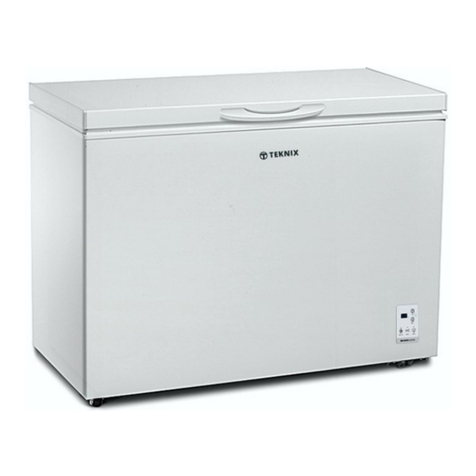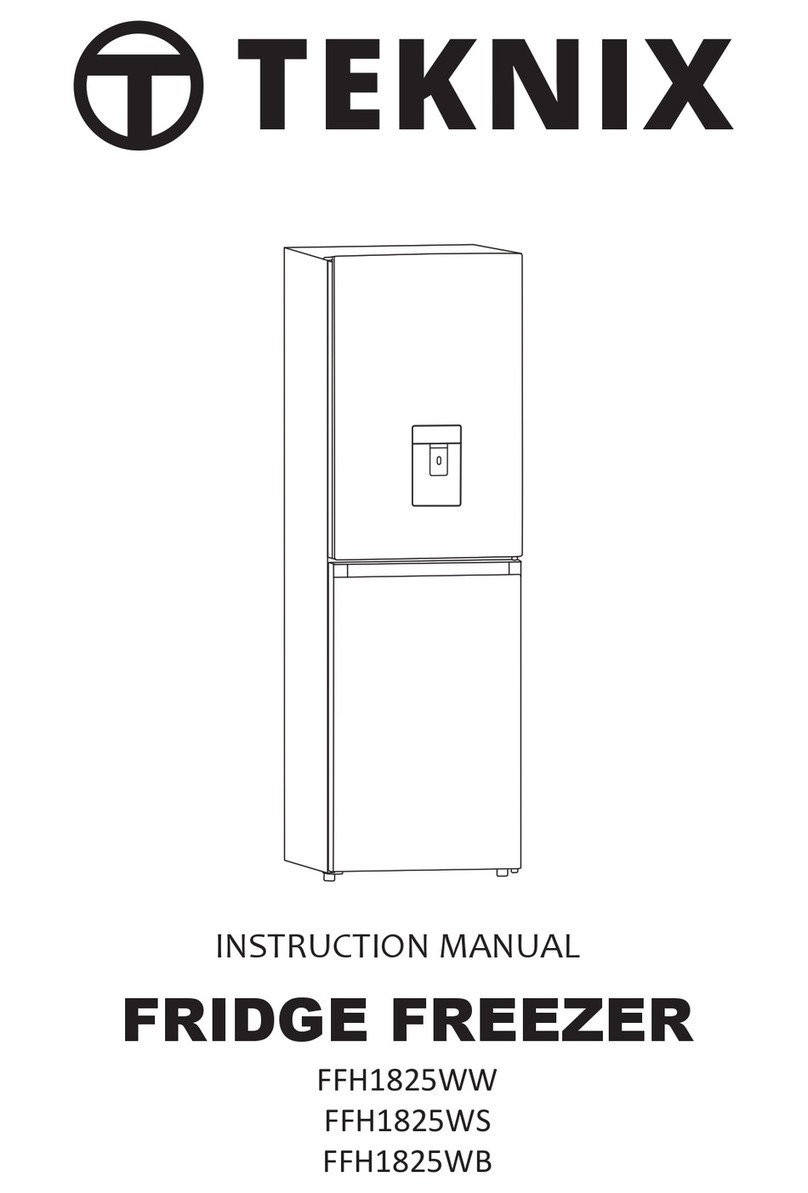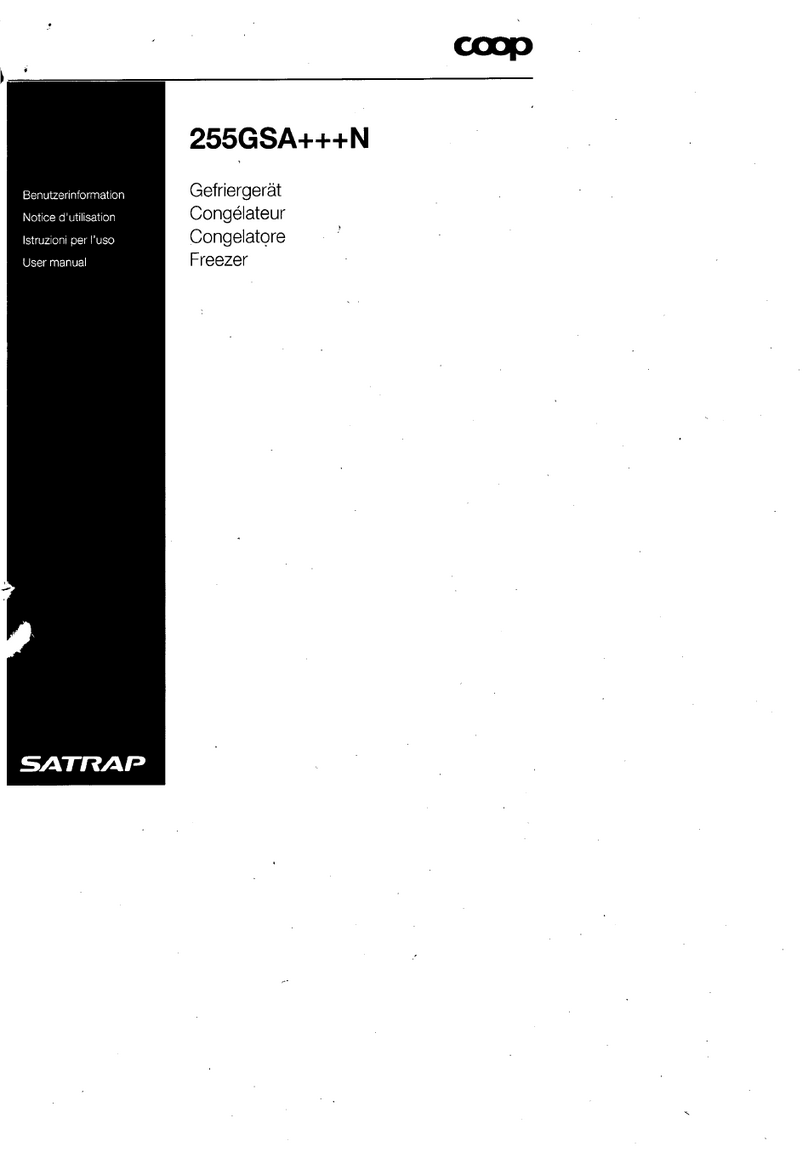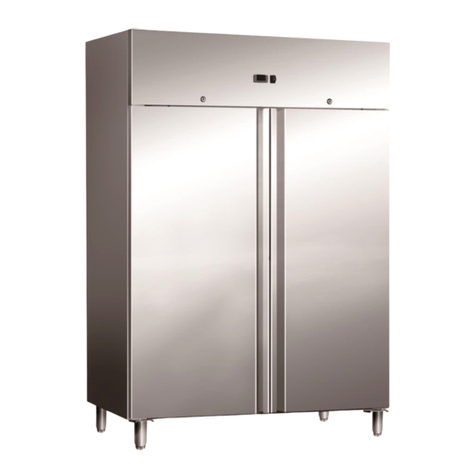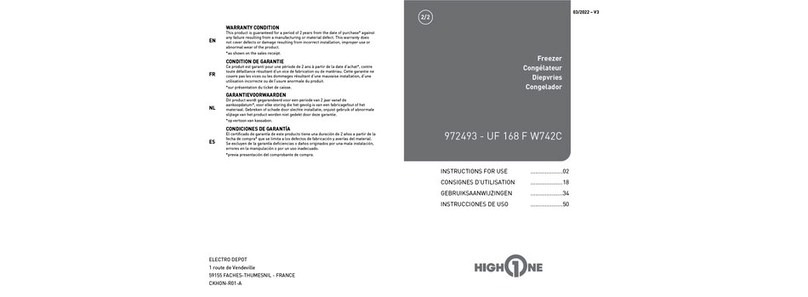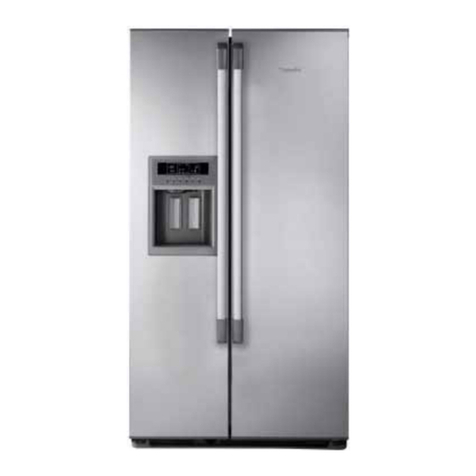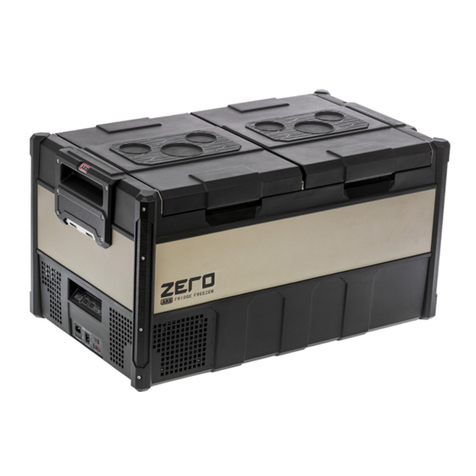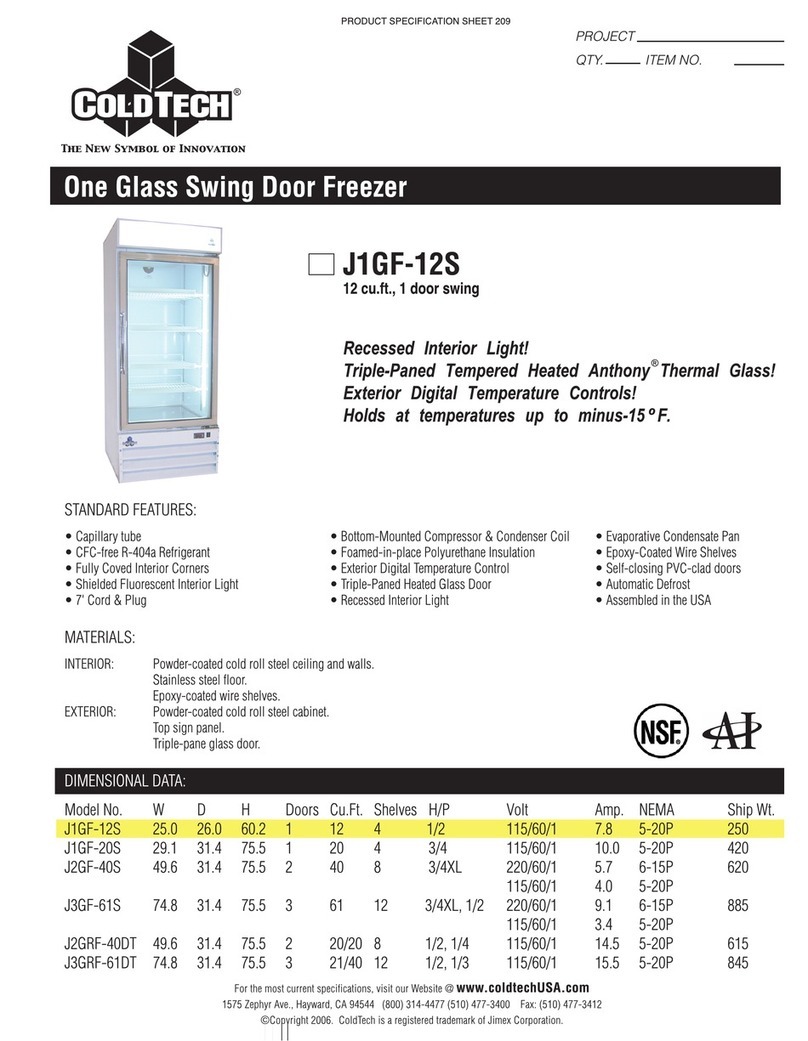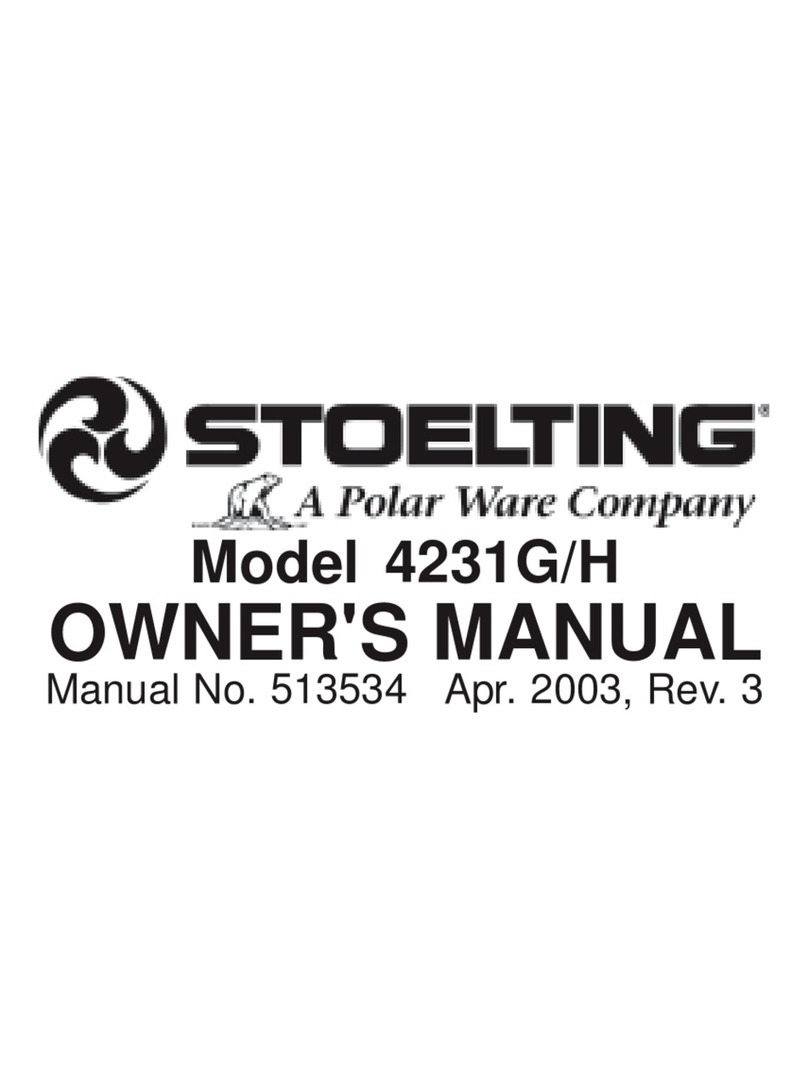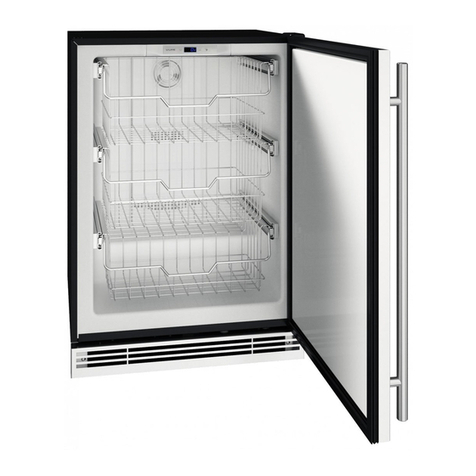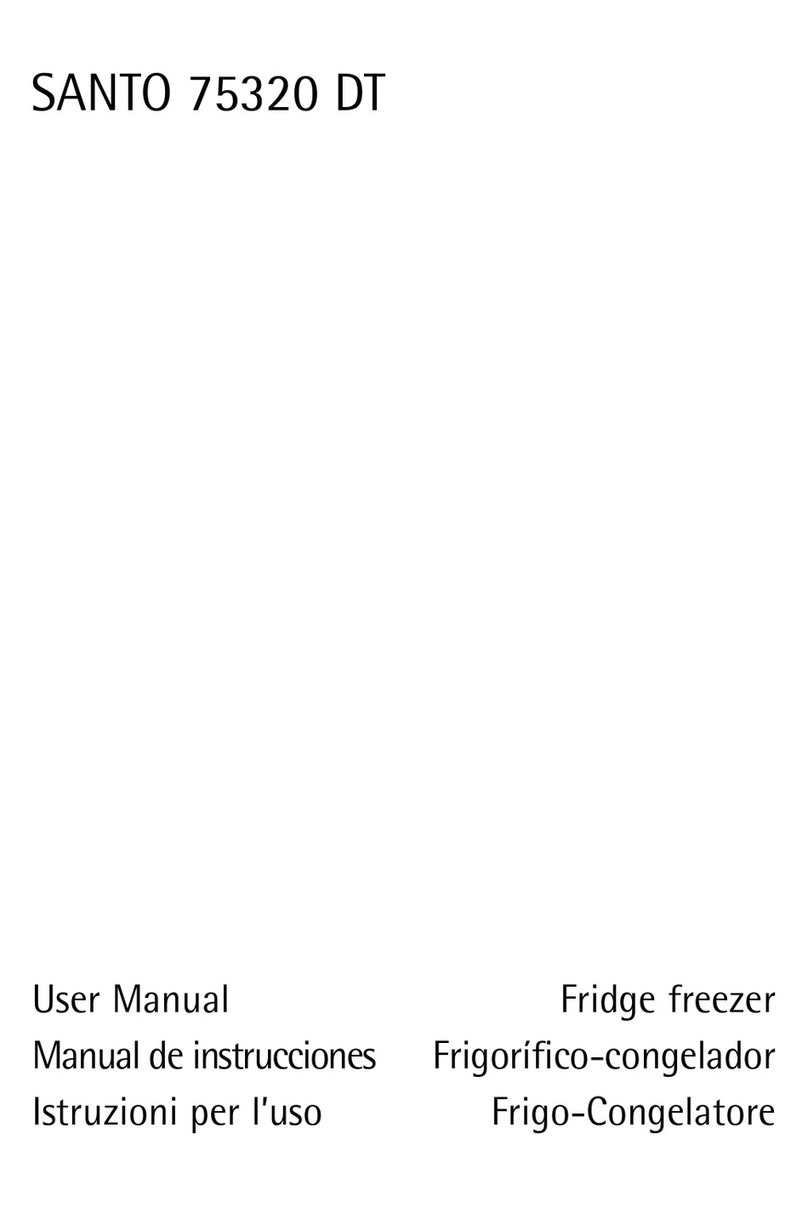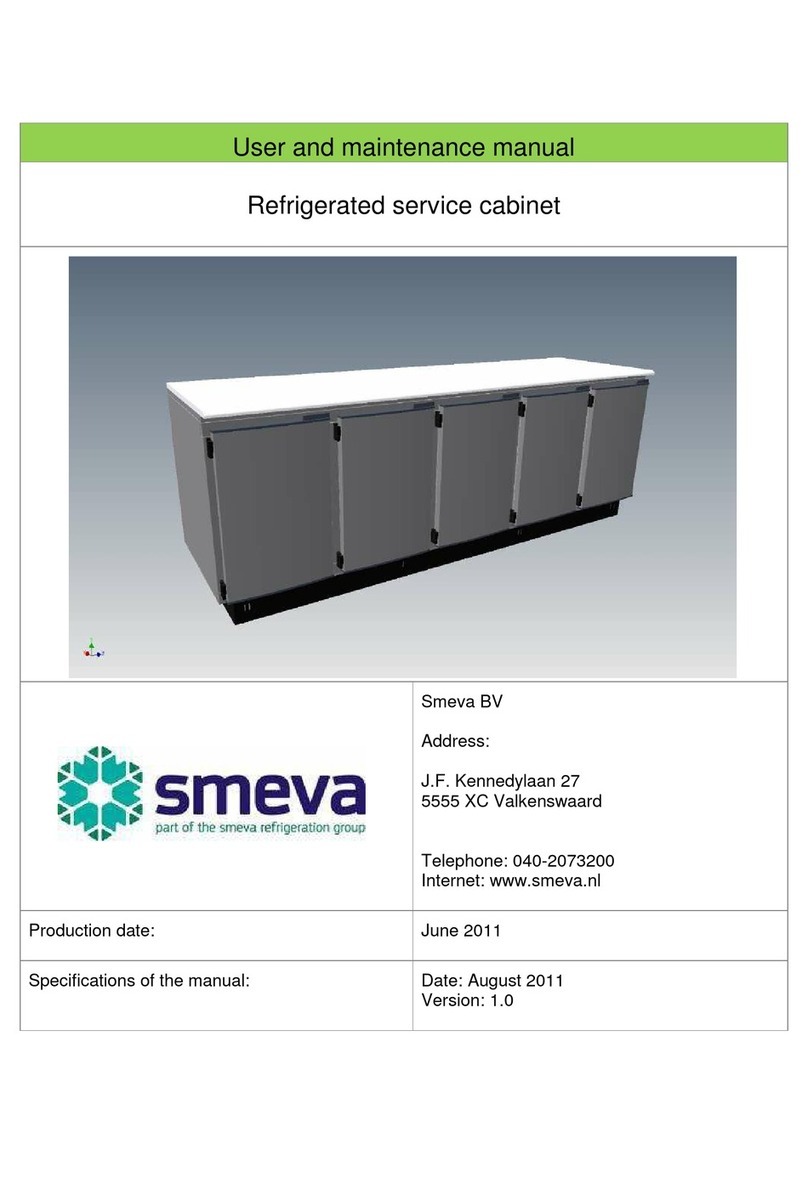TEKNIX UC55F2W User manual

UC55F2W

4If you require any technical guidance or nd that the product is not operating as intended, please see the Troubleshooting section of this manual
I. Safety Instructions
WARNING: It is hazardous for anyone other than authorised service personnel to
carry out servicing or repairs which involves the removal of covers. To avoid the
risk of an electric shock, do not attempt to repair this appliance yourself.
WARNING: Risk of re / ammable materials.
Safety Warnings and Information
WARNING: Do not use electrical appliances such as a hair dryer or heater to defrost your
Freezer.
WARNING: Containers with ammable gases or liquids can leak at low temperatures.
WARNING: Do not store any containers with ammable materials, such as spray cans, re
extinguisher, rell cartridges etc. in the Freezer.
WARNING: Do not place carbonated or zzy drinks in the Freezer compartment. Ice lollies
can cause “Frost/Freeze burns” if consumed straight from the Freezer.
WARNING: Do not remove items from the Freezer compartment if your hands are damp/wet,
as this could cause skin abrasions or “Frost/Freezer burns”. Bottles and cans must not be
placed in the Freezer compartment as they can burst when the contents freeze.
WARNING: Manufacturer’s recommended storage times should be adhered to. Refer to
relevant instructions.
WARNING: Do not allow children to tamper with the controls or play with the appliance.
IMPORTANT: The appliance is heavy. Care should be taken when moving it. It is dangerous
to alter the specication or attempt to modify this product in any way.
WARNING: Do not store ammable gases or liquids inside your Freezer.
IMPORTANT: If the power cable is damaged, it must be replaced by the manufacturer, its
service agent or similarly qualied persons in order to avoid a hazard.
WARNING: This appliance can be used by children aged from 8 years and above and persons
with reduced physical, sensory or mental capabilities or lack of experience and knowledge, if
they have been given supervision or instruction concerning use of the appliance in a safe way
and understand the hazards involved. Children shall not play with the appliance. Cleaning
and user maintenance shall not be made by children without supervision.
IMPORTANT: This appliance is intended to be used in household and similar applications
such as
– staff kitchen areas in shops, ofces and other working environments,
– farm houses and by clients in hotels, motels and other residential type environments,
– bed and breakfast type environments,
– catering and similar non-retail applications.
•Keep ventilation openings, in the appliance enclosure or in the built-in structure, clear of
obstruction..
•Do not use electrical appliances inside the food storage compartments of the appliance,
unless they are recommended by the manufacturer.

5If you require any technical guidance or nd that the product is not operating as intended, please see the Troubleshooting section of this manual
•Do not store explosive substances such as aerosol cans with a flammable propellant in
this appliance.
•This appliance is not intended for use by persons (including children) with reduced
physical, sensory or mental capabilities, or lack of experience and knowledge, unless
they have been given supervision or instruction concerning use of the appliance by a
person responsible for their safety. Children should be supervised to ensure that they do
not play with the appliance.
IMPORTANT: Keep ventilation openings in the appliance enclosure or in the built-in structure,
clear of obstruction.
WARNING: Do not use mechanical devices or other means to accelerate the defrosting
process, other than those recommended by the manufacturer.
WARNING: Do not damage the refrigerant circuit.
WARNING: Do not use electrical appliances inside the food storage compartments of the
appliance, unless they are of the type recommended by the manufacturer.
WARNING: Refrigerating appliances, in particular a refrigerator-freezer, might not operate
consistently (possibility of defrosting of contents or temperature becoming too warm in the
frozen food compartment), when appliance is running for an extended period of time, below
the cold end of the range of temperatures for which the refrigerating appliance is designed.
WARNING: It is necessary that, for doors or lids tted with locks and keys, the keys be kept
out of the reach of children and not in the vicinity of the refrigerating appliance, in order to
prevent children from being locked inside.
WARNING: The refrigerant used in your appliance and insulation materials requires special
disposal procedures.
WARNING: When positioning the appliance, ensure the supply cord is not trapped or
damaged.
WARNING: Do not locate multiple portable socket-outlets or portable power supplies at the
rear of the appliance
Children aged from 3 to 8 years are allowed to load and unload refrigerating appliances.
To avoid contamination of food, please adhere to the following instructions:
• Opening the door for long periods can cause a signicant increase of the temperature in
the compartments of the appliance.
• Clean regularly surfaces that can come in contact with food and have accessible
drainage systems.
• If the refrigerating appliance is left empty for long periods of time, switch off, defrost,
clean, dry, and leave the door open to prevent mould developing within the appliance.

6If you require any technical guidance or nd that the product is not operating as intended, please see the Troubleshooting section of this manual
Electrical Supply Connection
• Connect the appliance to the electrical supply (220-240 V ~ 50 Hz) with the plug and
lead, which are tted.
• Connections to the mains supply should be in accordance with local regulations.
• DO NOT use plug adapter.
• The appliance must be plugged into an earthed socket
• Always make sure that the plug is accessible after the appliance has been positioned.
• If the electrical cable is damaged or worn, turn off the refrigerator and consult an
authorised agent for replacement.
Electrical Safety
WARNING: When positioning the appliance, ensure the supply cord is not
trapped or damaged.
WARNING: DO NOT locate multiple portable socket- outlets or portable power
supplies at the rear of the appliance
DO NOT use plug adapter.
WARNING: Risk of re / ammable materials
• The plug must be accessible after installation.
• The operating voltage for your appliance is 220-240 V at 50Hz.
•Insert the plug into a socket with an efficient ground connection. If the socket has no
ground contact or the plug does not match, we recommend you consult a qualified
electrician for assistance.
•The appliance must be connected with a properly installed fused socket. The power
supply (AC) and voltage at the operating point must match with the details on the name
plate of the appliance (the name plate is located on the inside left of the appliance).
•The plug MUST be accessible after the appliance has been positioned. The cord should
be secured and not left exposed or dangling to prevent accidental injury.
•The appliance is supplied with a standard three-pin plug, of which the one for grounding
should never be removed.
• Hold the plug, not the electrical cable, when unplugging the appliance.
• Make sure that the appliance does not trap the electric cable.
• DO NOT step on the cable.
• Avoid damage to the electric cable when moving the appliance.
• This refrigerator appliance is not designed to be used with an inverter.
DO NOT use an extension cord with this appliance. If the power cord is too short, have
a qualied electrician or service technician install an outlet near the appliance. Use of an
extension cord can negatively affect the performance of the unit.
WARNING: Improper use of the grounded plug can result in the risk of electrical shock.
If the power cord is damaged, have it replaced by an authorised service provider.

7If you require any technical guidance or nd that the product is not operating as intended, please see the Troubleshooting section of this manual
Climate Range
The information about the climate range of the appliance is provided on the rated plate. It
indicates at which ambient temperature (that is, the room temperature in which the appliance
is working) the operation of the appliance is optimal (proper).
Climate range Permissible ambient temperature
SN from +10°C to +32°C
N from +16°C to +32°C
ST from +16°C to +38°C
T from +16°C to +43°C
Note: Given the limit values of the ambient temperature range for the climate classes for which the refrigerating
appliance is designed, and the fact that the internal temperatures could be affected by such factors as location
of the refrigerating appliance, ambient temperature and the frequency of door opening, the setting of any
temperature control device might have to be varied to allow for these factors, if appropriate.
Freon-free
The freon-free refrigerant (R600a) and the foaming insulation material (cyclopentane) are
used for this refrigerator and are environmentally friendly, causing no damage to the ozone
layer and having very small impact on global warming. R600a is ammable, and sealed in
a refrigeration system, without leakage during normal use. In the case of refrigerant leakage
due to the refrigerant circuit being damaged, be sure to keep the appliance away from open
ames and open the windows for ventilation as quickly as possible.

8If you require any technical guidance or nd that the product is not operating as intended, please see the Troubleshooting section of this manual
II. Product Features
Under Counter Larder Diagram
Note: Due to technological innovation, the product descriptions in this manual may not be
completely consistent with your refrigerator. Details are in accordance with the real product.
1 Top cover
2 Display Block
3 Freezer Flap
4 Middle Drawer
5 Low Drawer
6 Adjustable feet

9If you require any technical guidance or nd that the product is not operating as intended, please see the Troubleshooting section of this manual
III. Installation Instructions
Location
•When selecting a position for your Freezer you should make sure the floor is flat and
firm, and the room is well ventilated with an average room temperature of between 16ºC
and 38ºC.
•Avoid locating your Freezer near a heat source, eg, cooker, boiler or radiator. Also
avoid direct sunlight in out-buildings or sun lounges. If you are placing your Freezer in an
out-building such as a garage or annex ensure that the Fridge is placed above the damp
course, otherwise condensation will occur on the Freezer cabinet.
•Never place the Freezer in a wall recessed or into fitted cabinets or furniture when your
Freezer is working, the grills at the back may become hot and the sides warm. It must
therefore be installed so that the back of the Freezer has at least 9 cm (31/2”) of free
space and the sides have 2 cm (3/4”).
•Do not drape the Freezer with any covering.
Leveling the Freezer
•If the Freezer is not level, the door and magnetic seal alignment will be affected and may
cause you Fridge to work incorrectly. Once the Freezer is placed in its final location,
adjust the leveling feet at the front by turning them until you have a leveled appliance.
Cleaning before use
•Wipe the inside of the Freezer with a weak solution of bicarbonate of soda. Then rinse
with warm water using a damp sponge or cloth. Wash the baskets or draws in warm
soapy water and dry completely before replacing in the Freezer. The external parts of
the Freezer can be cleaned with wax polish.
Before plugging in
• IMPORTANT: Check that you have a socket which is compatible with the plug supplied
with the Fridge.
Before switching on
•IMPORTANT: After the Freezer is properly installed and well cleaned, do not switch it on
immediately. Make sure you allow a minimum of 4 hours before turning on the power of
the refrigerator. The coolant fluid needs time to settle. If the appliance is switched off at
any time, wait 30 minutes before switching back on to allow the coolant fluid to settle
Before filling your Freezer
•Before storing foods in your Freezer, turn the Freezer on and wait for 24 hours to make
sure it is working properly and to allow the Freezer to reach the desired temperature.

10 If you require any technical guidance or nd that the product is not operating as intended, please see the Troubleshooting section of this manual
IV. Starting your Freezer
1. Clean the parts of the Freezer with lukewarm clean water containing a neutral detergent,
then wipe them dry.
NOTE: Electric parts of the Freezer can only be wiped by a dry cloth.
2. Turn the thermostat knob to the "2" position, plug it into the wall outlet and then turn on
electricity. The compressor will begin to run.
3. Open the door 30 minutes later, if the temperature in the freezer has decreased
obviously, it shows that the cooling system works well.
Temperature Controls
1. The temperature control is a thermostat knob controlled by being turned with a coin. It is
located near the top of the unit.
2. Turning the thermostat knob adjusts the temperature of the freezer.
3. The marks on the knob represent different settings. Setting “1” is the warmest and setting
“4” is the coolest.
4. It is recommended to place the setting to “2” for normal operating conditions.
5. The achieved temperatures can vary according to the conditions of use of the appliance,
such as: place of the appliance, ambient temperature, and frequency of door opening, extent
of filling with food in the freezer.
6. Please remember each time the door is opened, cold air escapes and the internal
temperature rises. Therefore never leave the door open and ensure it is closed immediately
after food is put in or removed.

11 If you require any technical guidance or nd that the product is not operating as intended, please see the Troubleshooting section of this manual
•It is important not to exceed storage time(s) recommended by food manufacturers of
any kind of food.
•Food should be wrapped in aluminum foil, or other types of airtight packaging.
•Do not allow frozen foods in freezer to touch foods just placed into freezer.
•Cool hot food down to the room temperature before storing or consumption of
electricity will increase and would lead to frost forming inside.
•Frozen foods purchased at a store should be placed in freezer promptly so they do
not thaw.
•The external room temperature should be between 16ºC and 38ºC.
•Internal temperatures could be affected by such factors as the location of the freezer,
ambient temperature and the frequency of door opening. Therefore temperature
controls will need to be varied to allow for these factors.
•Effervescent drinks should not be stored in food freezer.
•Some products such as water ices should not be consumed straight from freezer as it
could cause frost bite.
•Store foods in the freezer based on the food manufactures recommended storage time.
•A rise in temperature of the frozen food during manual defrosting, maintenance or
cleaning could shorten the storage life of your food.
•In the event of an extended power outage or refrigerator not running effectively to
temperature, take care that food does not spoil or food may have reduced its shelf life.
•Pre-cooked food should be cooled properly: Allow pre-cooked food to cool down
before placing in the Freezer. This will help to stop the internal temperature of the
Freezer from rising.
•Shut the door: To prevent cold air escaping, try to limit the number of times you open
the door. When returning from shopping, sort foods to be kept in your Freezer before
opening the door. Only open the door to put food in or take it out.
•Do not store flammable gases or liquids in the freezer.
Storage of Food and Handy Tips

12 If you require any technical guidance or nd that the product is not operating as intended, please see the Troubleshooting section of this manual
Recommended storage periods
• For recommended food storage time, refer to the information given on your food
packaging.
Cleaning inside the Freezer
•Do not pour water over the appliance.
•The cavity should be cleaned periodically using a solution of bicarbonate of soda
and lukewarm water (5m to 0.5ltr of water).
•Clean accessories separately with soap and water. Do not put them in dishwasher
•Do not use abrasive products, detergents or soaps.
•After washing, rinse with clean water and dry carefully.
•When you have finished cleaning reconnect the plug with dry hands.
Cleaning outside the Fridge
•Use standard non-abrasive detergent diluted in warm water to clean the Freezer exterior,
or a standard furniture polish for the exterior of Freezer. Make sure the door is closed to
prevent the polish getting on the magnetic door seal or inside.
•The grill of the condenser at the back of the Freezer and the adjacent components can
be vacuumed using a soft brush attachment.
•Do not use harsh cleaners, scouring pads or solvents to clean any part of the Fridge.
Defrosting
• After a period of use, a thin layer of frost will be formed on the freezer compartment
inner wall (or evaporator) surface, which may affect the refrigeration performance if
exceeding 5mm in thickness. In such case, you need to gently scrape the frost off using
an ice scraper rather than the metal or sharp object. Frost needs to be cleared off every
3 months, or if the frost is affecting the normal use of the drawers and or the refrigeration
performance. Follow the following steps to remove frost:
1. Take out the frozen foods, shut off the mains power supply, open the refrigerator door,
and gently remove the frost from the inner wall with an ice scraper. To speed up the
thawing process, it is suggested to place a bowl of hot water inside the refrigerator/
freezer, and when the solid ice particles become loose, use an ice scraper to remove
from surface.
2. After defrosting, clean the fridge/freezer inside, and switch on the power supply.

13 If you require any technical guidance or nd that the product is not operating as intended, please see the Troubleshooting section of this manual
V. Troubleshooting and Maintenance
Troubleshooting
•If Power Cut?
>If internal temperature of freezer compartment is -18℃ or less when power returns
you are safe. The freezer will keep foods frozen for approximately 16 hours with the
door closed.
> Do not open the Freezer door more than necessary.
•The Freezer is exceptionally cold?
–You may have accidentally adjusted the thermostat control dial to a higher position.
•The Freezer is exceptionally warm?
–The compressor may not be working. Turn the thermostat control dial to the maximum
setting and wait a few minutes. If there is no humming noise, it is not working and you
should contact your after sales service provider.
•The Freezer is not working?
–Check it is plugged in and switched on. Check that the fuse in the plug has not blown.
–Plug in another appliance, such as a lamp to see if the socket is working.
–The Freezer should be placed in a well ventilated room with an ambient temperature of
between 16ºC and 38ºC. Leave the Freezer for 30 minutes. If this doesn’t resolve your
problem, please contact your after sales service provider.
•Condensation appears on the outside of the Freezer?
–This may be due to a change in the room temperature. Wipe off any residue moisture.
If the problem continues contact your after sales service provider.
•Hearing noises such as Gurgling or Whooshing?
–These noises are caused by the circulation of the refrigerant liquid in the cooling
system. It has become more pronounced since the introduction of CFC free gases. This
is not a fault and will not affect the performance of your Fridge.
•Hearing noises such as humming, purring or pulsating?
–This is the compressor motor working, as it pumps the refrigerant around the system.

14 If you require any technical guidance or nd that the product is not operating as intended, please see the Troubleshooting section of this manual
Installation
•Don’t cover or block the vents or grills of your appliance.
Vacation Time
•Turn off the freezer first and then unplug the unit from the wall outlet.
•Remove all the food.
•Clean the freezer.
•Leave the door open slightly to avoid possible formation of condensation, mould or odors.
•Use extreme caution in the case of children. The unit should not be accessible to child’s
play.
•Short vacations: Leave the freezer operating during vacations of less than three weeks.
•Long vacations: If the appliance will not be used for several months, remove all food and
unplug the power cord. Clean and dry the interior thoroughly. To prevent odor and mold
growth, leave the door open slightly.
• Location
–Do not place your Freezer near a heat source, eg. Cooker, boiler or radiator. Also
avoid direct sunlight in out-buildings or sun lounges.
•Leveling the Freezer
–Make sure the Freezer is level. Use the rotating leveling feet at the front. If the Freezer
is not level, the doors and magnetic seal alignments will be affected and may cause
your Freezer to work incorrectly.
–Do not turn on the Freezer for 4 hours once it is stationary and in place for use.
–After the Freezer is in place it needs to be left for 4 hours. This allows time for the
coolant to settle.
Moving the Freezer

15 If you require any technical guidance or nd that the product is not operating as intended, please see the Troubleshooting section of this manual
How to Save Energy
1. Install the freezer in the coolest part of the room, out of direct sunlight and away from
heating ducts or radiators. Do not place the freezer next to heat-producing appliances
such as a cooker, oven or dishwasher.
2. The freezer door should remain open only as long as necessary.
3. Do not place hot food inside the freezer.
4. Organise the freezer to reduce door openings.
5. The freezer door should be properly closed to avoid increased energy consumption,
and the formation of excess ice and / or condensation inside.
6. Constantly circulating cold air keeps the temperature consistent throughout the freezer.
For this reason, it is important to properly distribute the food to facilitate the flow of air.
7. Cover foods and wipe containers dry before placing them in the freezer. This cuts
down on moisture build-up inside the unit.
8. Do not overcrowd the freezer or block cold air vents. Doing so causes the freezer to
run longer and use more energy. Shelves should not be lined with aluminum foil, wax
paper or paper toweling. Liners interfere with cold air circulation, making the freezer
less efficient, which could cause food spoilage.
9. During prolonged absences (example: vacations), it is advisable to disconnect the
freezer, remove all the food, and clean it. The door should be left slightly open
to avoid mould and unpleasant odors. This will not affect the freezer when it is
reconnected.
10. During short absences (example: holidays), the freezer can remain on. However,
remember that prolonged power outages may occur while you are gone.
Servicing
• This product should be serviced by an authorised engineer and only genuine spare parts
should be used.
– Under no circumstances should you attempt to repair the appliance yourself.
– Repairs carried out by inexperienced persons may cause injury or serious
malfunctioning.
• Contact your local after sales service provider
– When the appliance is not in use for long period of time, disconnect from the
electricity supply, empty all foods and clean the appliance, leaving the door ajar to
prevent unpleasant smells.

16 If you require any technical guidance or nd that the product is not operating as intended, please see the Troubleshooting section of this manual
VI. Certications
Electrical information
This electrical appliance must be grounded.
This product is equipped with a plug, which is suitable for all houses equipped with sockets
meeting the current specications.
If the tted plug is not suitable for your socket outlets, it should be cut off and carefully
disposed of by a qualied electrician. To avoid a possible shock hazard, do not insert the
discarded plug into a socket.
This product complies the EEC directives.

17 If you require any technical guidance or nd that the product is not operating as intended, please see the Troubleshooting section of this manual
VII. Product Support
Declaration of conformance to product standards
This appliance conforms to all relavant standards applicable to domestic appliances sold in
the UK
Disposal
This appliance/tting is marked A according to the European directive 2012/19/
EU on Waste Electrical - and Electronic Equipment (WEEE). By ensuring this product
is disposed of correctly, you will help prevent potential negative consequences for the
environment and human health, which could otherwise be caused by inappropriate
waste handling of this product.
The symbol on the product, or on the documents accompanying the product, the
crossed out wheelie bin symbol, indicates that this appliance/tting may not be
treated as household waste. Instead it shall be handed over to the applicable
collection point for the recycling of electrical and electronic equipment.
Disposal must be carried out in accordance with local environmental regulations for
waste disposal.
For more detailed information about treatment, recovery and recycling of this
product, please contact your local authority, your household waste disposal service
or the retailer where you purchased the product.
Old fridges and freezers contain isolation material and refrigerant with CFC.
Therefore, take care not to harm the environment when you are discarding your old
fridges.

Guarantee
We, Teknix, undertake that if within 24 months of the date of purchase this appliance or any part thereof is proven to be defective by
reason of mechanical or electrical failure we will at our discretion repair or replace the same free of any charge for labour, materials or
carriage on condition that:
• The appliance has been correctly installed in accordance to manufacturers’ instructions.
• The appliance has been used for normal domestic purposes only and in accordance with our operating instructions.
• The appliance has not been repaired, taken apart or tampered with by any person not authorised by us.
• All repair work under this guarantee must be undertaken by the organisation or its authorised agents
• Proof of purchase is available on request
• If we decide your appliance cannot be repaired, or is uneconomical to repair, we'll replace it with the same model. If that model
is no longer available, we'll discuss an alternative settlement with you.
• We reserve the right to charge for the expense of a service call if no fault has been found with the appliance after we have
inspected it.
• All claims must be arranged via a call to us on 01759 487893. Without pre-authorisation it may result in the cost of claim not
being reimbursed.
This guarantee is in addition to your statutory and other legal rights
- Damage resulting from transportation, improper use, or neglect.
- Appliance outside the United Kingdom.
- Consumer replaceable items including, but not limited to, batteries, light bulbs and other consumables.
- Cosmetic damage and/or non-functional parts, which do not affect the normal use of the product including for example cabinet,
scratches and rust.
- - Any loss suffered as a result of not being able to use the appliance or any loss other than the repair or the replacement cost of the
product.
- Accidental or physical damage
Exclusions

TEKNIX
Table of contents
Other TEKNIX Freezer manuals
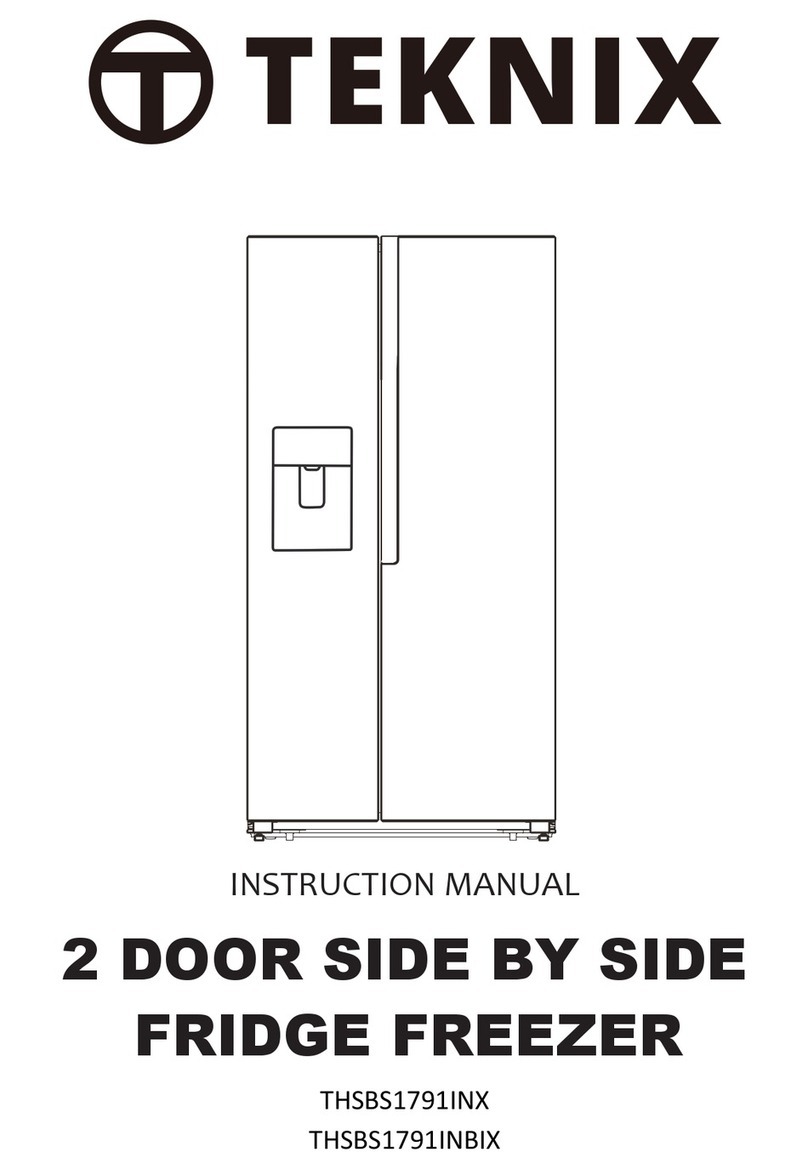
TEKNIX
TEKNIX THSBS1791INX User manual
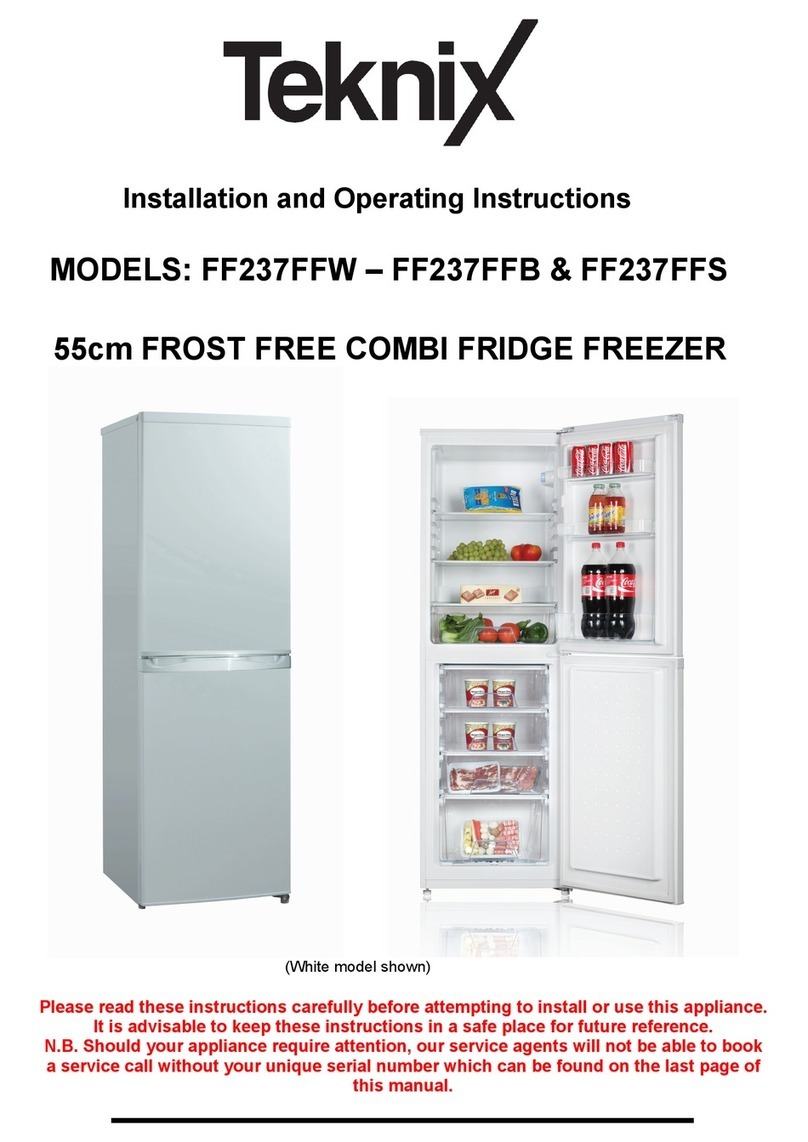
TEKNIX
TEKNIX FF237FFW User manual

TEKNIX
TEKNIX BITK503FF User manual

TEKNIX
TEKNIX THSBS17784X User manual
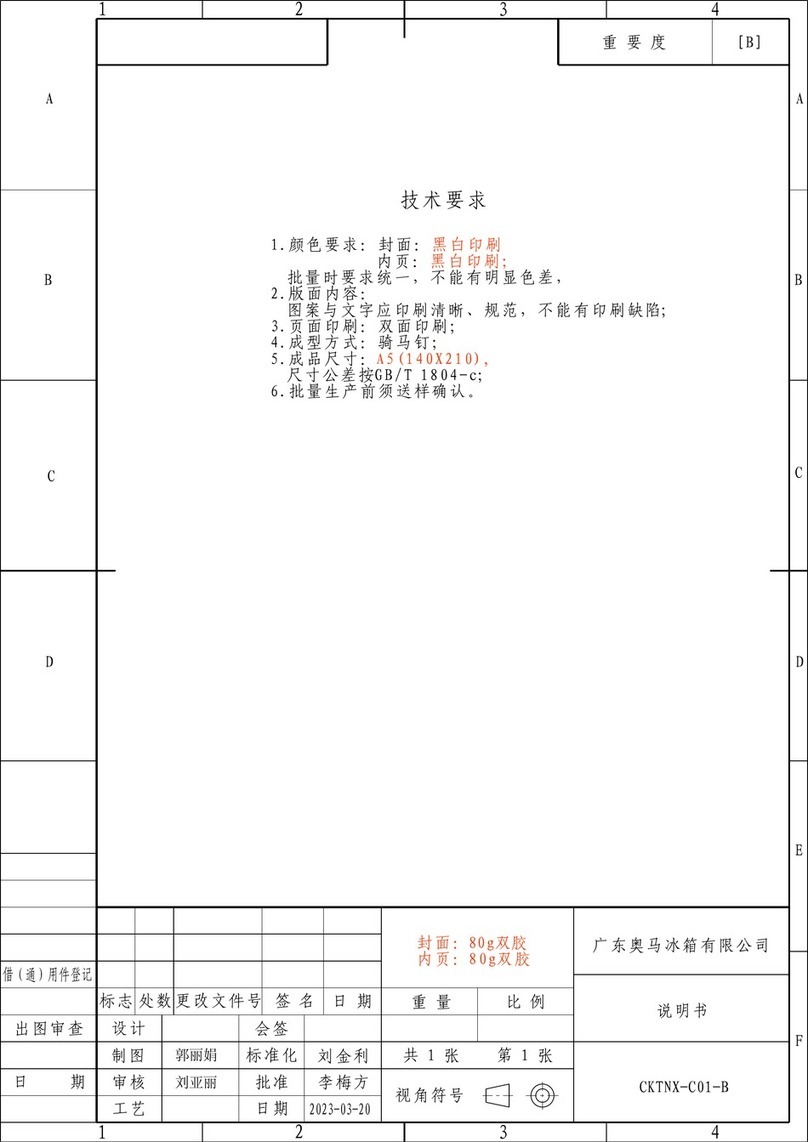
TEKNIX
TEKNIX T60FNF2W User manual
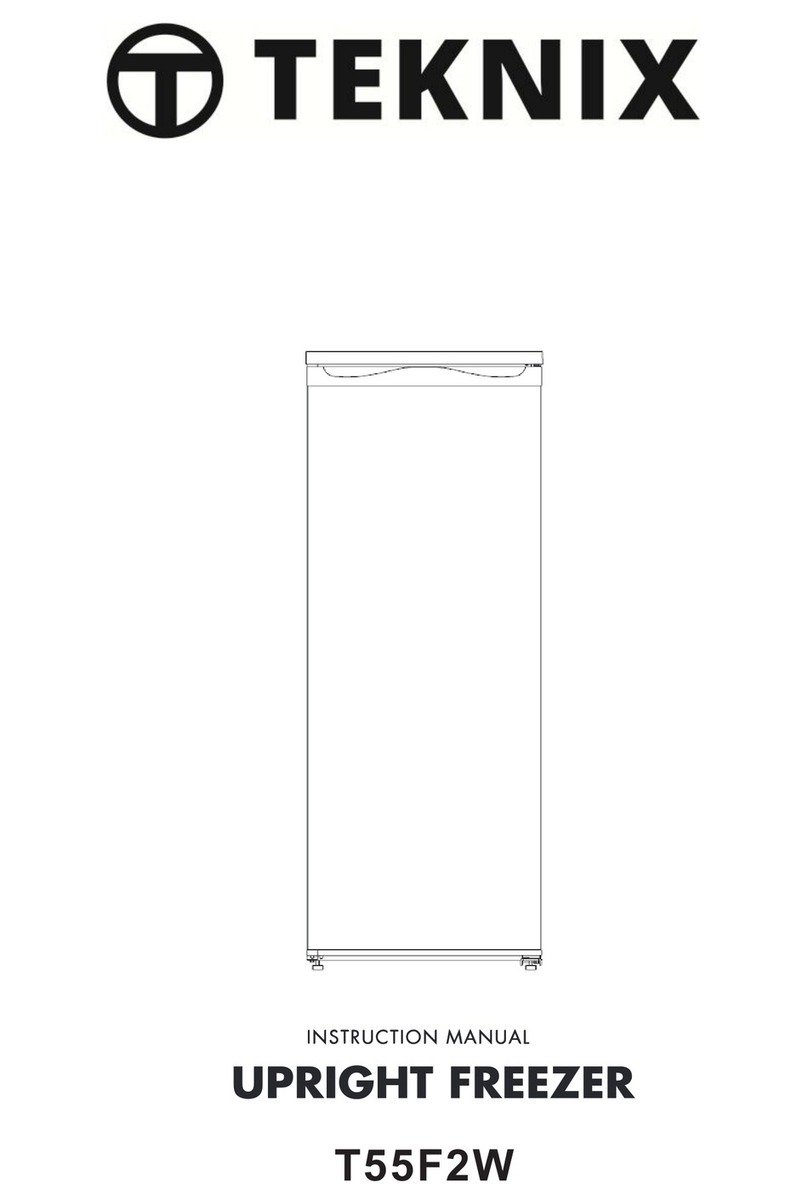
TEKNIX
TEKNIX T55F2W User manual
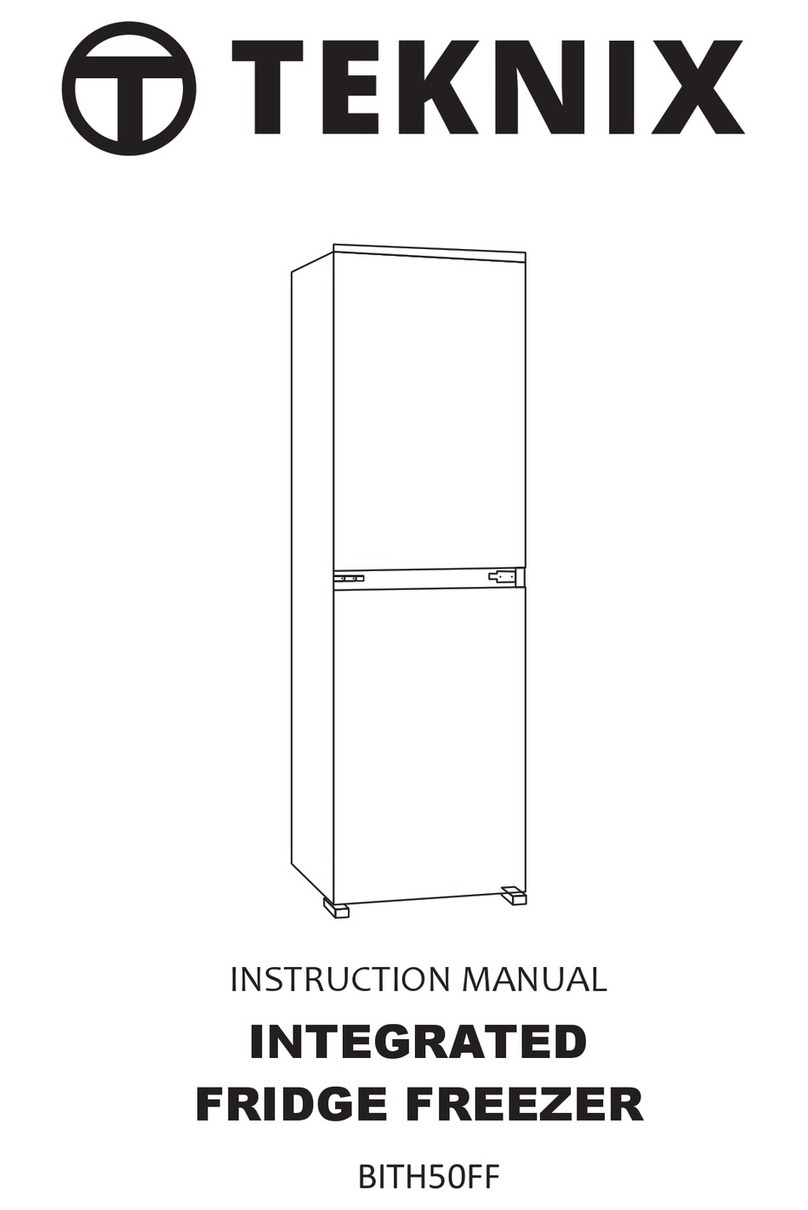
TEKNIX
TEKNIX BITH50FF User manual
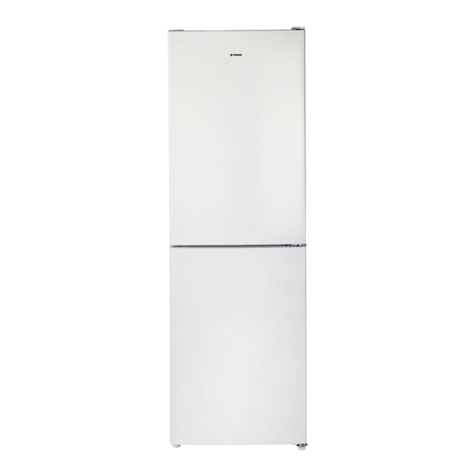
TEKNIX
TEKNIX FF1860W User manual
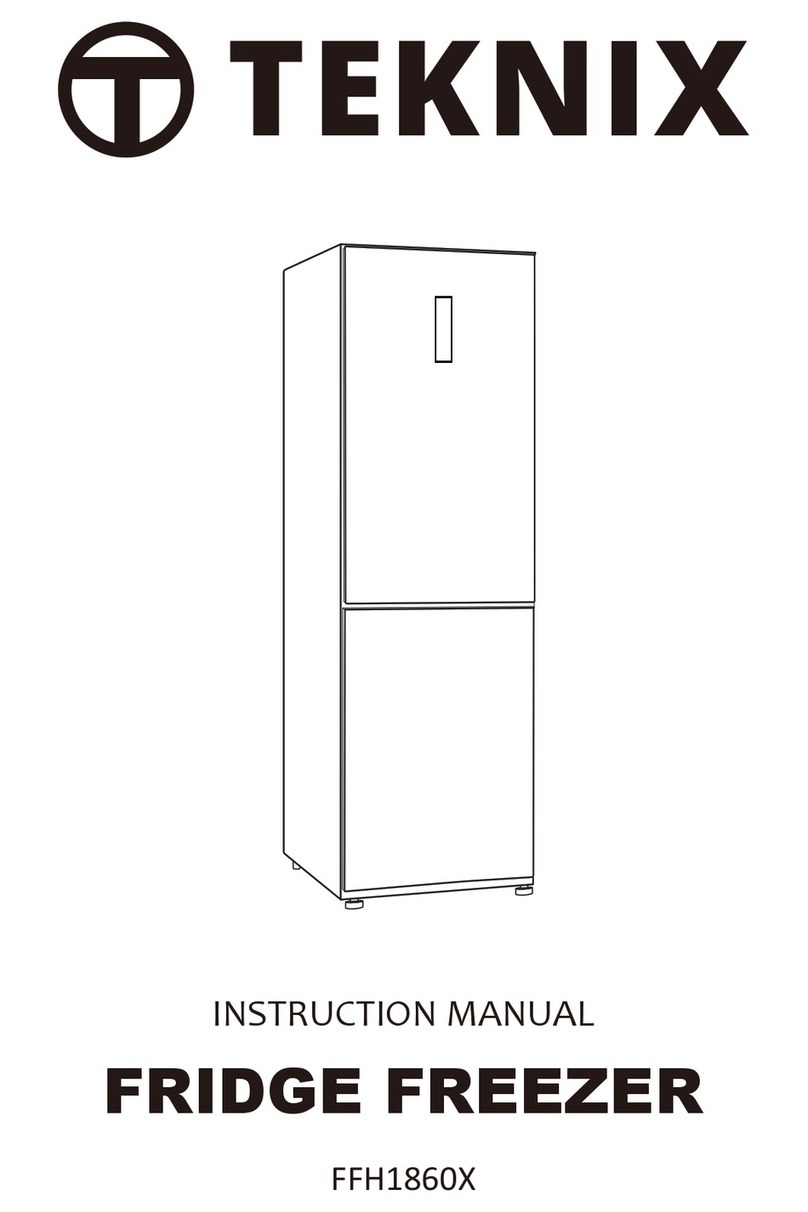
TEKNIX
TEKNIX FFH1860X User manual
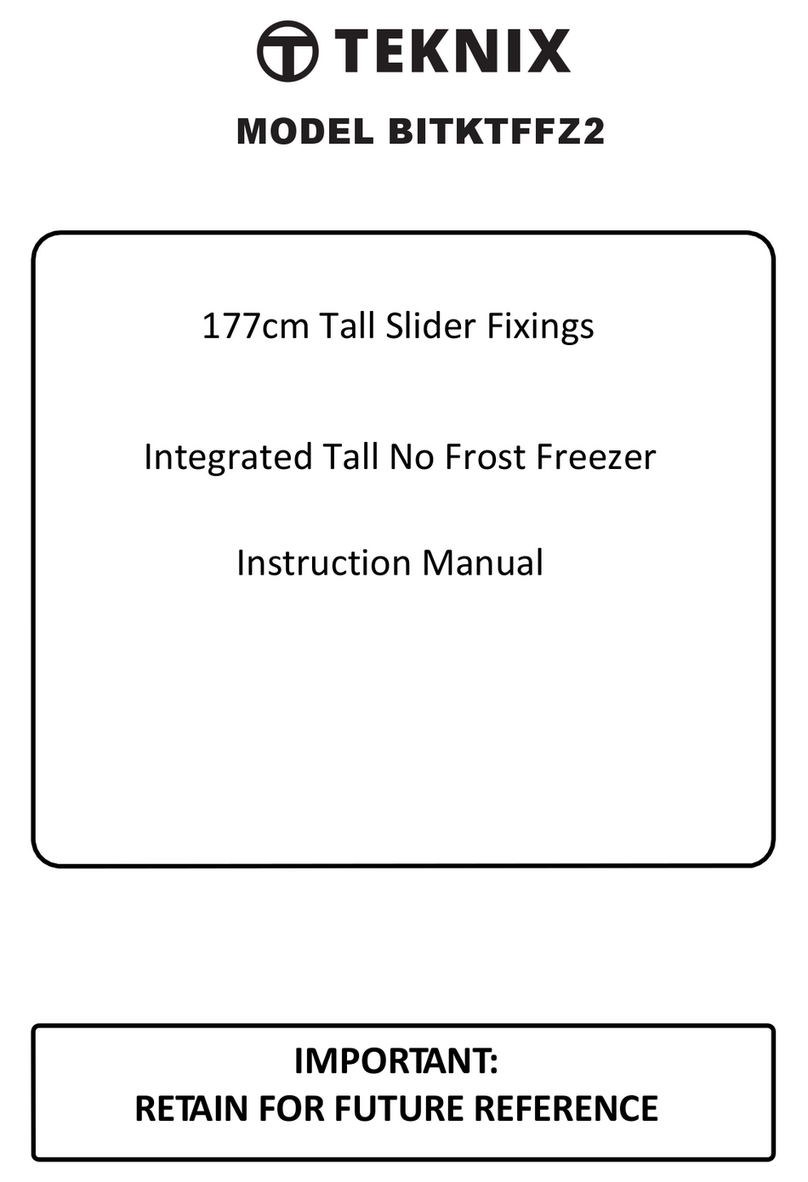
TEKNIX
TEKNIX BITKTFFZ2 User manual
